Razer mako
Those who are not the first to read me might have noticed a tendency - I try to review only what is new, good or non-standard.
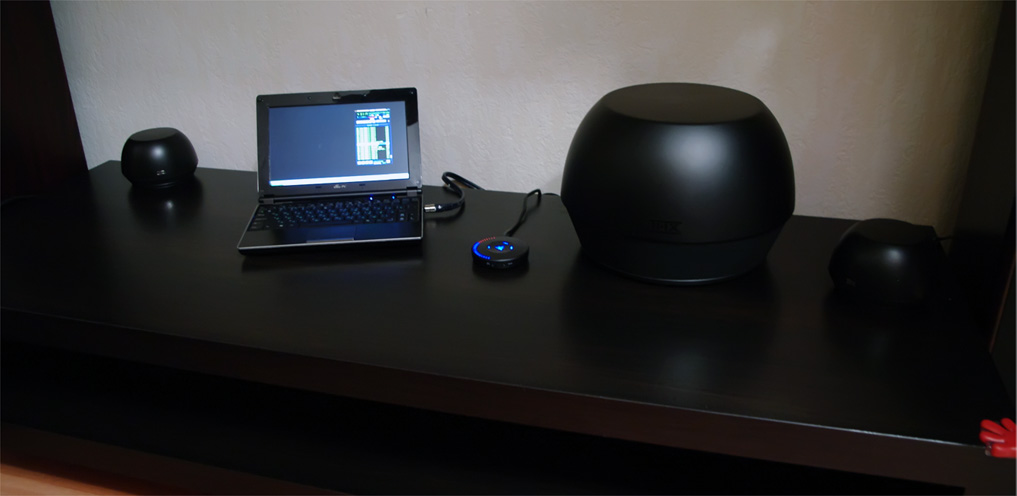
And today's review will not be an exception. Is the device new? Not really. Qualitative? Most interesting. Custom? Ooh yeah!!! )
The company Razer specializes in gaming devices, occasionally attempting the sweet cake of manufacturers of very different products. We have to admit that she does this rarely, but aptly - almost every product of it is subject to multiple disputes and discussions. Well, maybe marketers are doing their job well, and users are pretending that everything is super - I don’t really want to understand this. After all, it has long been known that demand creates supply ...
')
Nevertheless, I propose in advance not to pay attention to the opinions of those who have not seen these columns except in the pictures - a quick search showed that there are very many of them) It is a pity that IXBT did not carry out detailed testing - I would very much like to know their opinion on this set. Therefore, while I can offer only alternative reviews from RTLab and Hard'n'Soft .
Today on my desk (“ aha, still say in the test lab ” - note of the inner voice) the will of fate turned out to be an interesting desktop 2.1 audio system called the Razer THX Mako (and here you have a little Wikipedia article about the Mako shark - once and twice ). Despite the fact that this is a relatively non-core product for the company, it is not worth making hasty conclusions. Maybe at Razer themselves (more precisely, in this case Razer Audio Pte Ltd.) and not so many cones are full, but the laboratory of THX Ltd. (which took part in the development of this product) in the absence of experience, you can not blame.

The 2.1-channel multimedia speaker system has a total power of 300W (100W per sub and 4x50W for front two-way satellites with two amplifiers per channel), with the stated frequency range indicated as 25-20000 Hz. However, such elegant values do not speak about anything, since it is not known at what frequency response they have a place to be. Nevertheless, the company remains honest and indicates that the frequency range is already slightly less than 40-18000 Hz in terms of ± 2.5 dB, which, I must say, is a worthy value and is often found in much more expensive acoustics.
Clear, and most importantly, complete TTX is not found anywhere, so what is there. Here it is:

The box is big and heavy, but smaller and lighter than similar systems with a subwoofer in the shape of a cube. In the thickness of the foam were:
- Subwoofer and two satellite;
- Two wires for connecting the system (3 meters each);
- Network wire + adapter;
- Audio line (5 meters);
- Remote control;
- Papers.

It is very unusual, although similar spherical forms in acoustic devices have already met somewhere before.
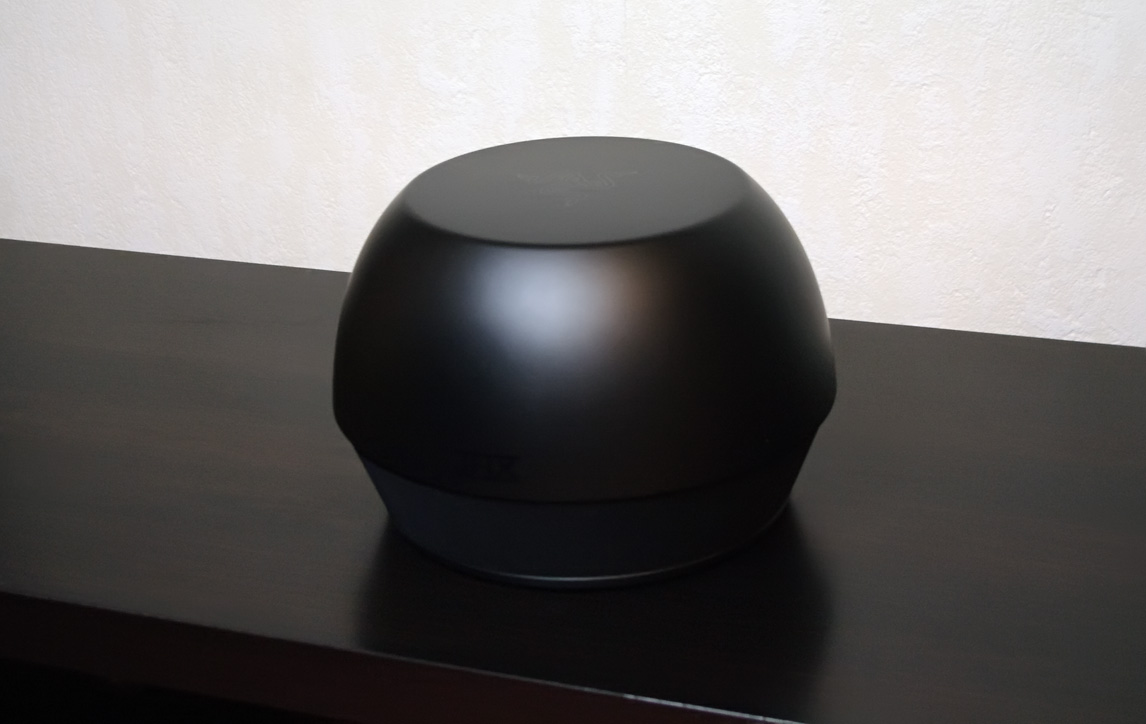
Two satellites (weighing about 500 grams each) have the same shape as the sub, only the latter is several times larger and weighs about 10 kilograms. Black matte plastic, from which the body is made, at first glance looks very reliable. Actually, he also looks at the second and third views)

On the top "covers" you can see glossy company logos (where you can go without them), and closer to the bottom you can see a fine metal mesh.

The bottom is black rubberized surfaces that confidently hold the system components in place.
Satellites join the “head system” by means of… network wires - at least, at first glance, they are very similar to them)

Judging by the number of cable cores, the conclusion suggests itself that the solution inside is not cheap anyway. Instead of a single amplifier and a passive crossover, which introduces strong distortion and depletes the original music signal, in the bi-amping connection (with channel-by-channel gain) at the MF / LF and HF components, the original signal is divided by an active crossover, after which each of the two streams is amplified individual amplifier. In theory, and almost always in practice, such an approach to sound processing provides a much clearer, more balanced and large-scale sound. Returning to the wires - I liked to snap the connectors much more than fiddling with wires and clips on the back of other speakers.
On the reverse side of the subwoofer (although it is almost round) there is a panel with connectors, among which, among other things, the VGA port is hidden.

It is used to connect a wired remote control. Approximately 1.5-meter cord, at the end of which is attached a flat round washer with a rubberized bottom.
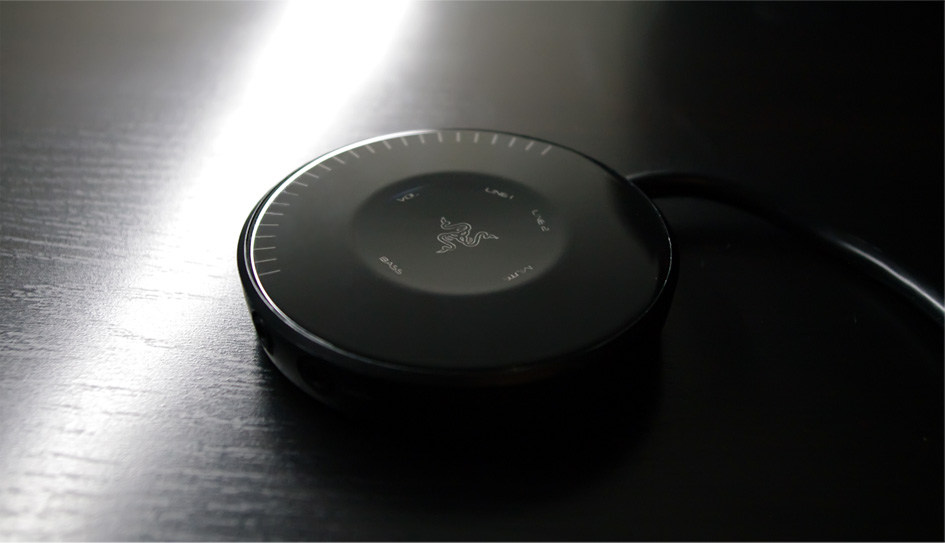
Above are the touch controls that glow in the dark - volume control, bass button, mute and select the sound source. At first, it’s not as easy to manage as I would like, but when you understand how it works, it’s convenient.

Due to the length of the cord of 1.5 meters, you can take out the “pancake” almost anywhere. Also at its end (more precisely, perhaps, the band) there are two audio jacks. In case the sound is needed, for example, at night, it is easier to insert the headphones into the console than to go to the system unit.
Undoubtedly, the wired remote imposes its limitations on versatility - rather, the system is more suitable for desktop use (i.e. for a table with a PC or laptop you are sitting at), rather than for sound from the table "from another corner of the room."
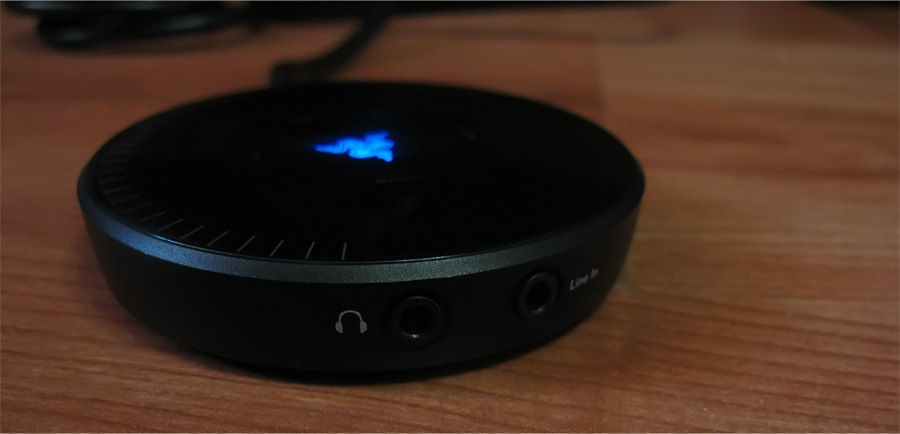
It seems to me that with such an approach, Razer unequivocally indicates that acoustics belong specifically to computer games. However, roll the "balls", it's time to listen.
All the uniqueness and singularity of the system lies in the way sound propagates.
Ordinary desktop speakers have the following location of the loudspeakers - on top (inside) is a tweeter, on the bottom - a woofer (on this word Punto played a cruel joke). In this situation, the user hears not only direct sound waves, but also reflected from the surface (on which the speakers are located).
The THX Ground Plane and THX Slot Speaker technologies used in the Razer THX Mako work on a different principle - the main goal is to achieve a wide sound field so that the listener feels himself in the thick of things. This is achieved due to the special design of the case and the location of the emitters (down), so that in the listening area we catch only the waves (propagating through 360 °), reflected from the table surface.

Accordingly, having closed my eyes, it will be quite difficult to accurately determine the sources of sound, due to their “multidirectionality”.

If with a physical sense at least a little something became more transparent, then the technology used in the subwoofer ( ClassHD Digital Amplifier Technology digital amplification) for me has remained an unexplored improvement. At IXBT, testing was not carried out, and the same review says: “ If you believe the advertising and explanatory picture, we are dealing with a kind of so-called BASH-class, the essence of which is to track the level of the input signal and“ inject ”a strictly metered amount of electricity into amplifying cascades. Separate signs indicate that the gain in Razer Mako is close to digital, but I don’t dare to say about pure class D without opening (of course, authorized). At the very least, control and “metering” are carried out by means of a DSP digital processor . ”
For clarity, I will show pictures of technology from the site:
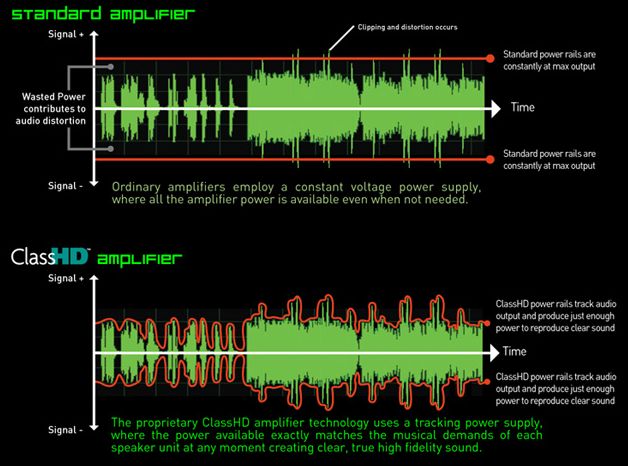
When you press the power button on the dashboard subwoofer, turn on the blue "snake" on the remote. Absolutely no noise from non-playing speakers is not - this is good. The sound was heard with the ASUS EeePC 1002HA and Cowon S9 . I didn’t play a “guess where the sound” game with the speakers, but really, the unusual atmosphere is felt even on the music. The bass is very good, I have not heard any unpleasant musical artifacts. The sound is clear and juicy - it is very likely that those who are not spoiled by technology for much more thousands will like it.
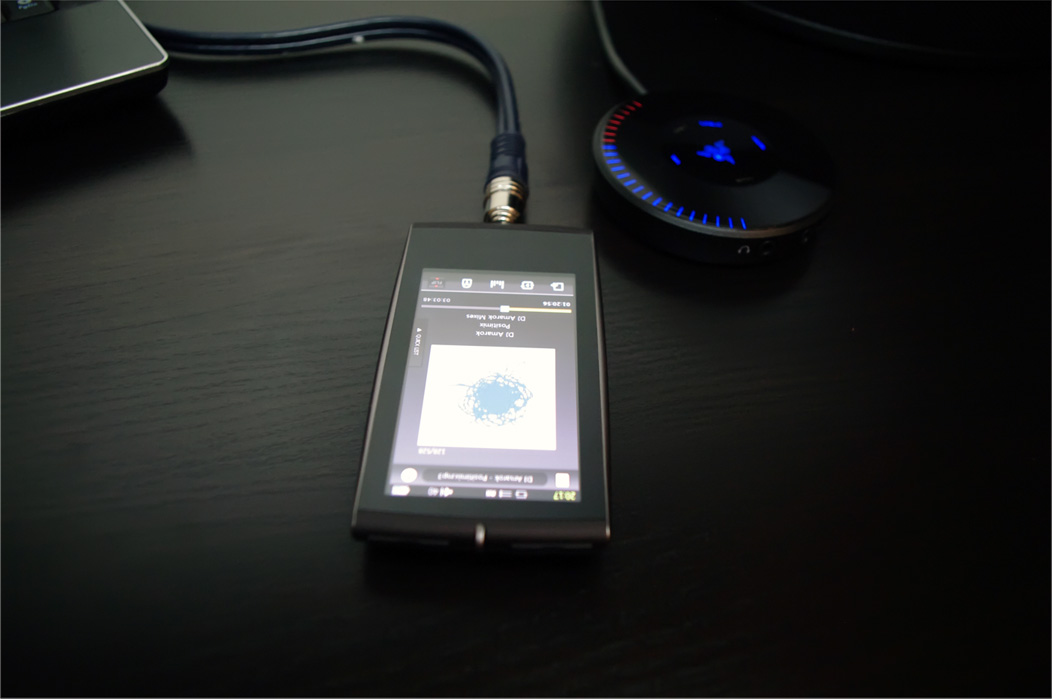
Good people threw an interesting record - the sound of a motorcycle motorcycle Harley Davidson. When I listened to this file ... I still wanted to sit down and go) Well, or at least look out the window in order to look at the iron horse. Unusually - download and try) Spatial effects at height.
During the games (again, I tried on Crysis; ASUS EssenceST sound card), the system also showed itself very well - explosions, shooting and other ahi-sighs look very realistic. For those who like to play with no headphones, the system is definitely suitable. The main thing is not to let the sound down in the game itself, although it seems that serious game makers are not particularly affected by this problem.
Despite the fact that the speakers are positioned as desktop, I tried the music not only on the computer table and a table under the TV, but also on the floor (laminate). Eh) toli my bear really stepped on my ear, toli really the results are almost the same - at least there is almost no obvious contrast. Since the table begins to vibrate under the action of the subwoofer (it is possible to work with it), it is better to remove all unnecessary - all sorts of pencil cases, organizers and other lamps. This will help get rid of spurious noise and other resonant phenomena. Being on the floor, there are no vibrations of the working space, but the sound becomes a little quieter.
It often happens that either the columns are decorative, but they do not distinguish notes, or they play well, but they want to be hidden in the closet. Here - a kind of symbiosis of quality, aesthetic beauty and originality. Nicely.
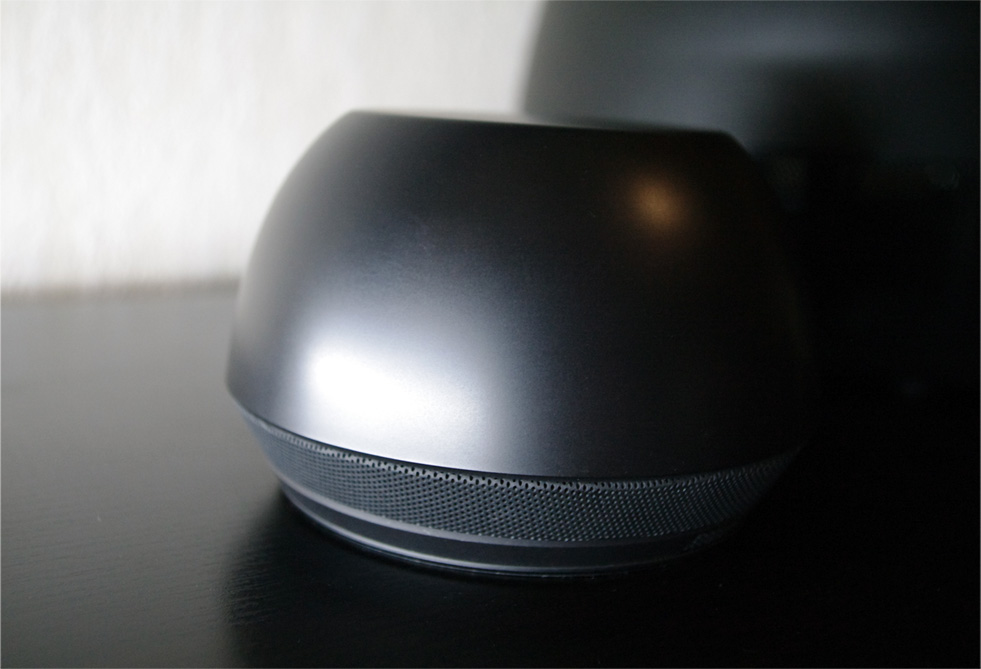
The only thing that was somewhat upset was the volume of the kit. She is at a decent level, but the neighbors will not go crazy with her. Or maybe it's a plus?
pros
- High-quality assembly and unusual appearance - whatever one may say, but attention attracts;
- Very high quality and full sound - will satisfy many music lovers;
- The touch panel with unobtrusive light indication;
- Small size.
Minuses
- You can not connect via optics or SPDIF;
- Non-universal wires to the satellite;
- Moderate volume;
- Remote wired;
- High price.
As for the price - it is different everywhere, but everywhere is high. On the official website of Razer, this is 12,810 rubles, on Price.ru - from 15 to 18, and on Yandex . Market there is none at all. Oh, and behind the hill only 299 raccoons.
Before taking - be sure to listen to them! Often you can meet them in some re: Store and White Wind stores (there is exactly on the Lubyanka).
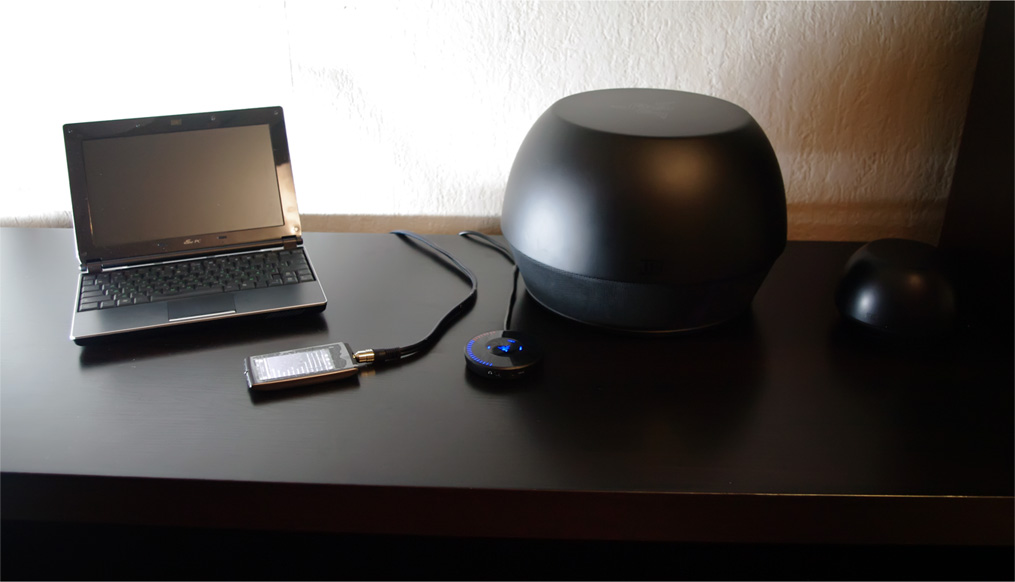
Well, in our market the price is traditionally inflated and for many it is one of the most significant drawbacks. If you close your eyes to this, then ... then we face a niche, but very high-quality 2.1-system, playing much better than many colleagues in the class. If you create the necessary conditions for the system, then it will greatly delight its owner with the elaboration of musical details and basses.
Even under the condition that the system has a huge number of competitors in its class (more precisely, the type is 2.1), it undoubtedly has the right to life. But if you dig a little deeper and take it as a point of reference that this system was created only for computer games, then the number of competitors immediately decreases. And if for audiophiles able to clearly see the difference in sound in headphones with oxygen-free copper wires from ordinary wires, this system may not be the best purchase, then for players and fans of high-quality sound without any claims for snobbery, these “balls” can be very pleasant purchase.
A purely personal opinion - the company once again managed to make a quality product, for which it reasonably wants a completely adequate amount of money. Here it is.
In this terrible twitter you can write me anything.
Successes!

And today's review will not be an exception. Is the device new? Not really. Qualitative? Most interesting. Custom? Ooh yeah!!! )
The company Razer specializes in gaming devices, occasionally attempting the sweet cake of manufacturers of very different products. We have to admit that she does this rarely, but aptly - almost every product of it is subject to multiple disputes and discussions. Well, maybe marketers are doing their job well, and users are pretending that everything is super - I don’t really want to understand this. After all, it has long been known that demand creates supply ...
')
Nevertheless, I propose in advance not to pay attention to the opinions of those who have not seen these columns except in the pictures - a quick search showed that there are very many of them) It is a pity that IXBT did not carry out detailed testing - I would very much like to know their opinion on this set. Therefore, while I can offer only alternative reviews from RTLab and Hard'n'Soft .
Today on my desk (“ aha, still say in the test lab ” - note of the inner voice) the will of fate turned out to be an interesting desktop 2.1 audio system called the Razer THX Mako (and here you have a little Wikipedia article about the Mako shark - once and twice ). Despite the fact that this is a relatively non-core product for the company, it is not worth making hasty conclusions. Maybe at Razer themselves (more precisely, in this case Razer Audio Pte Ltd.) and not so many cones are full, but the laboratory of THX Ltd. (which took part in the development of this product) in the absence of experience, you can not blame.

The 2.1-channel multimedia speaker system has a total power of 300W (100W per sub and 4x50W for front two-way satellites with two amplifiers per channel), with the stated frequency range indicated as 25-20000 Hz. However, such elegant values do not speak about anything, since it is not known at what frequency response they have a place to be. Nevertheless, the company remains honest and indicates that the frequency range is already slightly less than 40-18000 Hz in terms of ± 2.5 dB, which, I must say, is a worthy value and is often found in much more expensive acoustics.
Clear, and most importantly, complete TTX is not found anywhere, so what is there. Here it is:

The box is big and heavy, but smaller and lighter than similar systems with a subwoofer in the shape of a cube. In the thickness of the foam were:
- Subwoofer and two satellite;
- Two wires for connecting the system (3 meters each);
- Network wire + adapter;
- Audio line (5 meters);
- Remote control;
- Papers.

Appearance
It is very unusual, although similar spherical forms in acoustic devices have already met somewhere before.

Two satellites (weighing about 500 grams each) have the same shape as the sub, only the latter is several times larger and weighs about 10 kilograms. Black matte plastic, from which the body is made, at first glance looks very reliable. Actually, he also looks at the second and third views)

On the top "covers" you can see glossy company logos (where you can go without them), and closer to the bottom you can see a fine metal mesh.

The bottom is black rubberized surfaces that confidently hold the system components in place.
Satellites join the “head system” by means of… network wires - at least, at first glance, they are very similar to them)

Judging by the number of cable cores, the conclusion suggests itself that the solution inside is not cheap anyway. Instead of a single amplifier and a passive crossover, which introduces strong distortion and depletes the original music signal, in the bi-amping connection (with channel-by-channel gain) at the MF / LF and HF components, the original signal is divided by an active crossover, after which each of the two streams is amplified individual amplifier. In theory, and almost always in practice, such an approach to sound processing provides a much clearer, more balanced and large-scale sound. Returning to the wires - I liked to snap the connectors much more than fiddling with wires and clips on the back of other speakers.
On the reverse side of the subwoofer (although it is almost round) there is a panel with connectors, among which, among other things, the VGA port is hidden.

It is used to connect a wired remote control. Approximately 1.5-meter cord, at the end of which is attached a flat round washer with a rubberized bottom.

Above are the touch controls that glow in the dark - volume control, bass button, mute and select the sound source. At first, it’s not as easy to manage as I would like, but when you understand how it works, it’s convenient.

Due to the length of the cord of 1.5 meters, you can take out the “pancake” almost anywhere. Also at its end (more precisely, perhaps, the band) there are two audio jacks. In case the sound is needed, for example, at night, it is easier to insert the headphones into the console than to go to the system unit.
Undoubtedly, the wired remote imposes its limitations on versatility - rather, the system is more suitable for desktop use (i.e. for a table with a PC or laptop you are sitting at), rather than for sound from the table "from another corner of the room."

It seems to me that with such an approach, Razer unequivocally indicates that acoustics belong specifically to computer games. However, roll the "balls", it's time to listen.
Impressions
All the uniqueness and singularity of the system lies in the way sound propagates.
Ordinary desktop speakers have the following location of the loudspeakers - on top (inside) is a tweeter, on the bottom - a woofer (on this word Punto played a cruel joke). In this situation, the user hears not only direct sound waves, but also reflected from the surface (on which the speakers are located).
The THX Ground Plane and THX Slot Speaker technologies used in the Razer THX Mako work on a different principle - the main goal is to achieve a wide sound field so that the listener feels himself in the thick of things. This is achieved due to the special design of the case and the location of the emitters (down), so that in the listening area we catch only the waves (propagating through 360 °), reflected from the table surface.

Accordingly, having closed my eyes, it will be quite difficult to accurately determine the sources of sound, due to their “multidirectionality”.

If with a physical sense at least a little something became more transparent, then the technology used in the subwoofer ( ClassHD Digital Amplifier Technology digital amplification) for me has remained an unexplored improvement. At IXBT, testing was not carried out, and the same review says: “ If you believe the advertising and explanatory picture, we are dealing with a kind of so-called BASH-class, the essence of which is to track the level of the input signal and“ inject ”a strictly metered amount of electricity into amplifying cascades. Separate signs indicate that the gain in Razer Mako is close to digital, but I don’t dare to say about pure class D without opening (of course, authorized). At the very least, control and “metering” are carried out by means of a DSP digital processor . ”
For clarity, I will show pictures of technology from the site:

When you press the power button on the dashboard subwoofer, turn on the blue "snake" on the remote. Absolutely no noise from non-playing speakers is not - this is good. The sound was heard with the ASUS EeePC 1002HA and Cowon S9 . I didn’t play a “guess where the sound” game with the speakers, but really, the unusual atmosphere is felt even on the music. The bass is very good, I have not heard any unpleasant musical artifacts. The sound is clear and juicy - it is very likely that those who are not spoiled by technology for much more thousands will like it.

Good people threw an interesting record - the sound of a motorcycle motorcycle Harley Davidson. When I listened to this file ... I still wanted to sit down and go) Well, or at least look out the window in order to look at the iron horse. Unusually - download and try) Spatial effects at height.
During the games (again, I tried on Crysis; ASUS EssenceST sound card), the system also showed itself very well - explosions, shooting and other ahi-sighs look very realistic. For those who like to play with no headphones, the system is definitely suitable. The main thing is not to let the sound down in the game itself, although it seems that serious game makers are not particularly affected by this problem.
Despite the fact that the speakers are positioned as desktop, I tried the music not only on the computer table and a table under the TV, but also on the floor (laminate). Eh) toli my bear really stepped on my ear, toli really the results are almost the same - at least there is almost no obvious contrast. Since the table begins to vibrate under the action of the subwoofer (it is possible to work with it), it is better to remove all unnecessary - all sorts of pencil cases, organizers and other lamps. This will help get rid of spurious noise and other resonant phenomena. Being on the floor, there are no vibrations of the working space, but the sound becomes a little quieter.
It often happens that either the columns are decorative, but they do not distinguish notes, or they play well, but they want to be hidden in the closet. Here - a kind of symbiosis of quality, aesthetic beauty and originality. Nicely.

The only thing that was somewhat upset was the volume of the kit. She is at a decent level, but the neighbors will not go crazy with her. Or maybe it's a plus?
Check weighing
pros
- High-quality assembly and unusual appearance - whatever one may say, but attention attracts;
- Very high quality and full sound - will satisfy many music lovers;
- The touch panel with unobtrusive light indication;
- Small size.
Minuses
- You can not connect via optics or SPDIF;
- Non-universal wires to the satellite;
- Moderate volume;
- Remote wired;
- High price.
As for the price - it is different everywhere, but everywhere is high. On the official website of Razer, this is 12,810 rubles, on Price.ru - from 15 to 18, and on Yandex . Market there is none at all. Oh, and behind the hill only 299 raccoons.
Before taking - be sure to listen to them! Often you can meet them in some re: Store and White Wind stores (there is exactly on the Lubyanka).

Tadam
Well, in our market the price is traditionally inflated and for many it is one of the most significant drawbacks. If you close your eyes to this, then ... then we face a niche, but very high-quality 2.1-system, playing much better than many colleagues in the class. If you create the necessary conditions for the system, then it will greatly delight its owner with the elaboration of musical details and basses.
Even under the condition that the system has a huge number of competitors in its class (more precisely, the type is 2.1), it undoubtedly has the right to life. But if you dig a little deeper and take it as a point of reference that this system was created only for computer games, then the number of competitors immediately decreases. And if for audiophiles able to clearly see the difference in sound in headphones with oxygen-free copper wires from ordinary wires, this system may not be the best purchase, then for players and fans of high-quality sound without any claims for snobbery, these “balls” can be very pleasant purchase.
A purely personal opinion - the company once again managed to make a quality product, for which it reasonably wants a completely adequate amount of money. Here it is.
In this terrible twitter you can write me anything.
Successes!
Source: https://habr.com/ru/post/74515/
All Articles